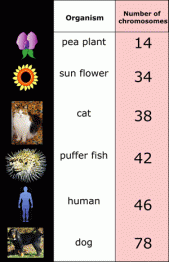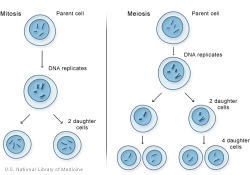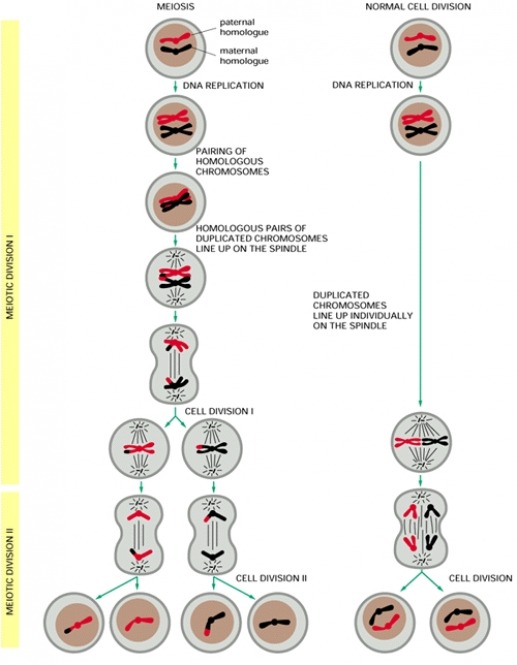Mitosis and meiosis are cellular chromosome doubling and division processes. Meiosis and mitosis are similar in some ways and also different.
Mitosis and Meiosis Overview
In mitosis the chromosome events are asexual. Mitotic chromosomes are doubled and shared equally between 2 cells. In meiosis the chromosomes first are doubled as in mitosis. Next, there are 2 cellular divisions (rather than the 1 of mitosis). These 2 meiotic cell divisions give 4 cell products termed "gametes". Mitosis and meiosis are compared here to show how each works and what happens to the chromosomes. See Figures 2 and 3 below for real comparisons of mitosis and meiosis.
Mitosis and Meiosis Basic Terms and Facts
Each chromosome is one DNA double helix. Every plant or animal species studied has a known and defined chromosome number. Chickens, pigs, cows, elephants, turtles, dogs, cats, roundworms, beans, corn, bacteria and human beings and all other organisms each have defined chromosome numbers.
Basic Terms Used in Genetics and Heredity
Mitosis and meiosis share these common features and similarities:
Mitosis and meiosis, despite similarities, are different:
Sources
Lodish, H. et al. 2000. Molecular Cell Biology . Fourth Ed., W. H. Freeman and Co., New York, N.Y.
Snustad, D.P., M.J. Simmons, and J.B. Jenkins., Principles of Genetics . John Wiley & Sons Inc., N.Y.
Mitosis and Meiosis Overview
In mitosis the chromosome events are asexual. Mitotic chromosomes are doubled and shared equally between 2 cells. In meiosis the chromosomes first are doubled as in mitosis. Next, there are 2 cellular divisions (rather than the 1 of mitosis). These 2 meiotic cell divisions give 4 cell products termed "gametes". Mitosis and meiosis are compared here to show how each works and what happens to the chromosomes. See Figures 2 and 3 below for real comparisons of mitosis and meiosis.
Mitosis and Meiosis Basic Terms and Facts
Each chromosome is one DNA double helix. Every plant or animal species studied has a known and defined chromosome number. Chickens, pigs, cows, elephants, turtles, dogs, cats, roundworms, beans, corn, bacteria and human beings and all other organisms each have defined chromosome numbers.
Basic Terms Used in Genetics and Heredity
- DNA – a macromolecule that contains nitrogen bases (adenine, guanine, thymine and cytosine) and codes for information in discrete packages termed genes
Double Helix – the common form of DNA with two chains of nitrogen bases wrapped around each other
Chromosome, is a single double helix of DNA with some protein - Paternal, means from the father or of the father; e.g. a paternal chromosome is one of the male parent's chromosomes
- Maternal, means from the mother or of the mother; e.g. a maternal chromosome is one of the female parent's chromosomes
- Homologous chromosome, or homolog, is a chromosome of similar type, function or size; homologous chromosomes are matching or paired chromosomes that have similar genes although one or many of these genes may be different. For example, chromosome # 1 from a human male, and # 1 from a human female are homologous chromosomes or homologs
- Heterologous chromosomes are chromosomes of different type and function. Example, chromosome 1 and any chromosome other than 1 are heterologous chromosomes; therefore, chromosomes 1 and 2, 2 and 7, 3 and 1 are all simple examples of heterologous chromosomes.
- Paired chromosomes are homologous chromosomes that form paternal-maternal pairs during meiosis.
- Chromatid, a duplicated chromosome, joined by a common centromere, to the other duplicated chromosome. These new chromosomes are composed of 1/2 new DNA and 1/2 old DNA becuase they have been duplicated by semiconservative replication
- Centromere, a constricted region on a chromosome that defines the upper and lower regions (arms) of the chromosome. The centromere mainly serves to link chromosomes to spindle fibers during mitosis and meiosis
- Spindle, an array of microtubules, that serve for chromosome attachment and chromosome distribution to daughter cells during mitosis and meiosis
- Diploid (2n), the full, normal chromosome number of a cell; in humans 46 is the diploid number
- Tetraploid (4n), twice the normal amount of DNA. Tetraploid condition means that there is 2X the normal chromosome number. Tetraploidy results after completed and full DNA synthesis during the S-phase of the cell cycle, and before any division occurs by either mitosis or meiosis.
- Haploid (n), half the full chromosome amount. The chromosome or nuclear condition of gametes (egg or sperm cells) that results after the completion of meiosis.
- Mitosis, the asexual chromosomal separation process that produces 2 diploid (2n) cells.
- Meiosis, the sexual division process characterized by 2 rounds of divisions that causes a tetraploid cell to form 2 diploid cells which, upon dividing again, form 4 sex cells. (typically, 4 sperm, or 1 egg and 3 accessory nourishing cells).
Mitosis and meiosis share these common features and similarities:
- new cellular DNA is synthesized (manufactured or replicated) to form tetraploid (4n) DNA
- this replication or sysnthesis gives 2X the full chromosome number or DNA amount before any division (2 x 2n = 4n)
- prophase, metaphase, anaphase and telophase stages are visible by staining and microscopy
- cytokinesis yields 2 new cells after one division in both mitosis and meiosis
- chemical signals initiate mitosis and meiosis in each cell's nucleus
Mitosis and meiosis, despite similarities, are different:
- mitosis occurs in many different tissues of animals and, in plants, the meristems and the cambium are mitotic tissues.
- meiosis only occurs in specialized tissues such as gonads (ovaries and testes) in animals, and anthers and ovaries in flowering plants. These are specialized tissues where meiosis occurs to produce gametes like sperms and eggs.
- mitosis has only 1 complete sequence of chromosome division and cytokinesis; meiosis has 2 complete rounds of chromosome divisions and 2 cytokinesis events.
- mitosis results in cells with diploid (2n) chromosome numbers, meiosis yields very specialized, reproductive cells with haploid (n) chromosome numbers. Haploid (n) cells can fuse with an appropriate mate or matching cell to reconstitute a diploid state (2n).
- mitosis maintains regularity and uniformity of the chromosomes in 2 new replicated cells. Meoisis causes the formation of a zygote or fertilized egg with different, recombinant chromosomes. Recombination is the result of 2 important processes: 1. crossing-over between paternal and maternal homologous, sister chromatids and, 2. independent assortment of paternal and maternal chromosomes causes various new combinations of paternal and maternal chromosomes.
Sources
Lodish, H. et al. 2000. Molecular Cell Biology . Fourth Ed., W. H. Freeman and Co., New York, N.Y.
Snustad, D.P., M.J. Simmons, and J.B. Jenkins., Principles of Genetics . John Wiley & Sons Inc., N.Y.
VISIT Our Science Super School Store with selected, valuable, quality items for learning and doing great science.
All the Written Material within Site is Copyrighted 2010 and Owned by Dr. Donald Reinhardt, and this original material is protected legally by this copyright notice and by the Digital Millennium Act. None of this original material may be copied or reproduced without the expressed written consent of the author.
The author is a Freelance Science writer, and is available for specific assignments for those who are interested – by contacting adminstrator@sciencesuperchool.com. Other questions related to this teaching site should be directed to teacher@sciencesuperschool.com.
All the Written Material within Site is Copyrighted 2010 and Owned by Dr. Donald Reinhardt, and this original material is protected legally by this copyright notice and by the Digital Millennium Act. None of this original material may be copied or reproduced without the expressed written consent of the author.
The author is a Freelance Science writer, and is available for specific assignments for those who are interested – by contacting adminstrator@sciencesuperchool.com. Other questions related to this teaching site should be directed to teacher@sciencesuperschool.com.


